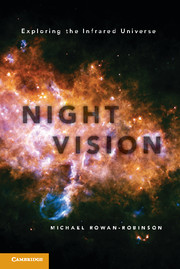Book contents
- Frontmatter
- Contents
- Preface
- 1 Introduction
- 2 William Herschel Opens Up the Invisible Universe
- 3 1800–1950
- 4 Dying Stars Shrouded in Dust and Stars Being Born
- 5 Birth of Submillimetre Astronomy
- 6 The Cosmic Microwave Background, Echo of the Big Bang
- 7 The Infrared Astronomical Satellite and the Opening Up of Extragalactic Infrared Astronomy
- 8 The Cosmic Background Explorer and the Ripples, the Wilkinson Microwave Anisotropy Probe and Dark Energy
- 9 Giant Ground-Based Near-Infrared and Submillimetre Telescopes
- 10 The Infrared Space Observatory and the Spitzer Space Telescope
- 11 Our Solar System’s Dusty Debris Disk and the Search for Exoplanets
- 12 The Future
- Epilogue
- Notes
- Credits for Illustrations
- Glossary
- Further Reading
- Bibliography
- Name Index
- Subject Index
6 - The Cosmic Microwave Background, Echo of the Big Bang
Published online by Cambridge University Press: 05 March 2013
- Frontmatter
- Contents
- Preface
- 1 Introduction
- 2 William Herschel Opens Up the Invisible Universe
- 3 1800–1950
- 4 Dying Stars Shrouded in Dust and Stars Being Born
- 5 Birth of Submillimetre Astronomy
- 6 The Cosmic Microwave Background, Echo of the Big Bang
- 7 The Infrared Astronomical Satellite and the Opening Up of Extragalactic Infrared Astronomy
- 8 The Cosmic Background Explorer and the Ripples, the Wilkinson Microwave Anisotropy Probe and Dark Energy
- 9 Giant Ground-Based Near-Infrared and Submillimetre Telescopes
- 10 The Infrared Space Observatory and the Spitzer Space Telescope
- 11 Our Solar System’s Dusty Debris Disk and the Search for Exoplanets
- 12 The Future
- Epilogue
- Notes
- Credits for Illustrations
- Glossary
- Further Reading
- Bibliography
- Name Index
- Subject Index
Summary
The story so far has been of stars shrouded in dust, clouds of gas and dust where new stars are forming, and nearby star-forming galaxies. Now we shift the stage to the whole universe with the discovery of background radiation at microwave wavelengths. The cosmic microwave background (CMB) radiation is the dying whisper of the initial fireball phase of the hot Big Bang universe, and its discovery transformed our understanding of the universe. This background is the dominant form of astronomical radiation at submillimetre wavelengths outside the Milky Way. When astronomers were trying to detect submillimetre sources in the 1970s, nodding the telescope between the source position and a nearby position on the sky to subtract out the emission from the Earth’s atmosphere, each telescope beam would detect an amount of CMB radiation far brighter than the source they were trying to detect. However, because they were only interested in the difference between the two measurements, the CMB radiation exactly cancelled and did not affect the observations. In this chapter, I describe the discovery of the radiation and its impact on cosmology.
The story of the discovery of the cosmic microwave background by Arno Penzias and Bob Wilson in 1965 has been told many times. Initially this was a story of short-wavelength radio astronomy and microwaves (centimetre wavelength radiation), but gradually it became clear that the wavelength of peak energy is around 1 millimetre, so while about half the CMB is microwave, half is submillimetre. To understand the significance of this radiation, we have to understand the origin and evolution of the universe itself.
- Type
- Chapter
- Information
- Night VisionExploring the Infrared Universe, pp. 73 - 83Publisher: Cambridge University PressPrint publication year: 2013



